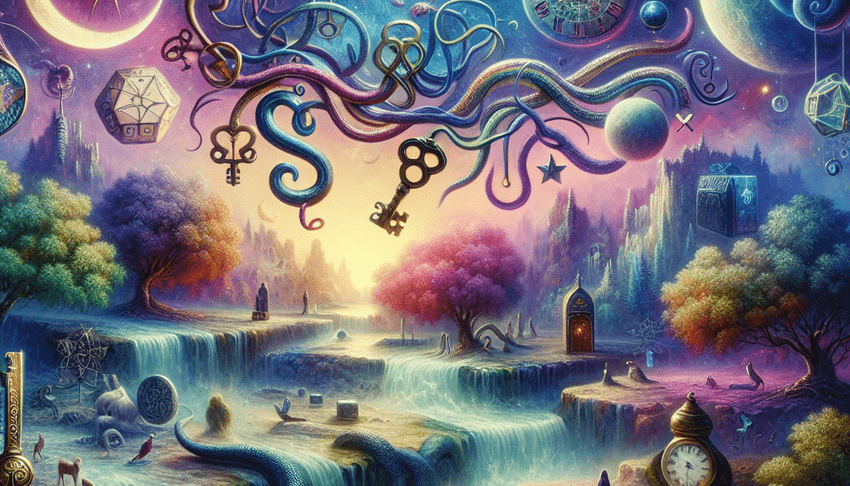Table of Contents
The Evolution of Dream Interpretation in Literature

Ancient Scriptures and The Birth of Dream Symbolism
Dream interpretation in literature and art dates back to ancient civilizations, where dreams were often seen as divine messages or prophecies. The Egyptians, Greeks, and Romans meticulously chronicled dreams in their mythologies and sacred texts, believing them to be communications from the gods or deceased ancestors.
Egyptian Dream Beliefs
The Egyptians were pioneers in dream interpretation, as evidenced by the ‘Chester Beatty Papyrus’, a manuscript dedicated to this practice. They regarded dreams as insights into the spiritual world and considered them equally critical as the events occurring in the waking life. One notable example is the ‘Dream Book’ inscribed in the Temple of Ramses II, listing various dreams and their meanings.
Greek and Roman Dream Lore
Ancient Greeks integrated dreams into their mythologies with entities like Morpheus, the god of dreams, playing a pivotal role. Dreams in literature, such as Homer’s ‘Odyssey’, illustrated the belief in prophetic visions delivered by the gods during sleep. Similarly, the Romans placed significant importance on dreams, with works like Cicero’s ‘De Divinatione’ discussing the philosophical and spiritual implications of dreaming.
- Epic of Gilgamesh: Often cited as one of the earliest masterpieces of world literature, it contains dream narratives that are central to the hero’s insights and fate. Its interpretation of visions and dreams has influenced literary exploration of dream symbolism for centuries.
- The Bible: Throughout this sacred text, dreams are depicted as messengers of God’s will – from Joseph’s prophetic dreams in ‘Genesis’ to Daniel’s interpretation of dreams in his eponymous book. It demonstrates how ancient scriptures view dreams as mediums for counsel and prediction.
Dream interpretation in literature and art served as a cornerstone for achieving personal revelation and spiritual guidance. The artistic representations of dreams within these texts further illustrate the significance attributed to the subconscious mind’s wanderings.
By interpreting the dreams found in ancient texts like the Epic of Gilgamesh and the Bible, we see how these early interpretations set a foundation for our current understanding of dreams. Some researchers argue that the symbolic language in dreams portrayed in these works is an ancestral language shared across cultures, shaping the collective unconscious explored in modern psychology by figures like Carl Jung.
The profound impact of these ancient perspectives persists in today’s dream interpretation practices. The legacy of interpreting dreams as layered with meaning continues to enrich the literary exploration of dream symbolism, encouraging us to appreciate dreams not only as nightly escapades but as potent narratives embedded in our cultural heritage.
Contemporary Literary Dreamscapes
Dream interpretation in literature and art has always played a pivotal role, and it continues to beguile audiences and scholars alike. In the realm of contemporary literary dreamscapes, authors artfully use dreams as a device to deepen character psychology, forecast future developments, and provide a canvas where the subconscious mind interfaces intriguingly with the narrative.
Artistic representations of dreams within modern narratives often serve as a gateway for readers to delve into the uncharted territories of a character’s inner life. One poignant example is Haruki Murakami’s “Kafka on the Shore”, where dream sequences blur the lines between reality and the supernatural. Murakami’s dreamscapes allow readers to interpret the potential future and the emotional complexities of his characters. Dreams in this work do not merely reflect the characters’ internal states but propel the plot forward in unexpected ways, leaving a significant impression on the interpretation of the story.
Another literary exploration of dream symbolism shines through in Neil Gaiman’s “The Sandman” series. This graphic novel seamlessly weaves dream motifs into its fabric, literally personifying Dream as a character who governs the dream world. For Gaiman, dreams are a realm just as vital as reality, presenting possibilities for exploring universal themes of desire, destiny, and death.
Engaging the Subconscious
A key aspect of dream analysis in contemporary literature lies in engaging the subconscious. When characters experience dreams that connect to their waking lives, readers are also invited to ponder the significance behind these dream symbols. In “The Secret Life of Bees” by Sue Monk Kidd, the protagonist’s recurring dreams of her mother serve as a poignant thread that ties her quest for identity and resolution with the past.
Dreams as Prophetic Visions
Dreams can also serve as prophetic visions, hinting at events yet to come. The use of prophecy in dreams is notably present in George R.R. Martin’s “A Song of Ice and Fire”, where characters like Bran Stark and Daenerys Targaryen are guided by their dreams, significantly affecting their decisions and the overarching plot. These dreams imbue the narrative with a sense of destiny and imminent importance, capturing the readers’ curiosity about the unfolding storyline.
Metafictional Elements
Moreover, the metafictional elements of dreams are tools that contemporary authors wield with finesse. In works like Jennifer Egan’s “A Visit from the Goon Squad”, dreams merge with the flow of the narrative to question the nature of time and reality, challenging the reader’s perception of linear storytelling.
By weaving dream interpretation and symbolism into their works, these contemporary authors enrich their texts with complex layers that stand at the crossroads of reality, prophecy, and psychological insight. They echo the timeless nature of dream analysis while simultaneously carrying it forward into new territories, capturing the essence and fascination of dreams within the powerful frame of literature.
Artistic Manifestations of Dream Symbolism

Artistic Manifestations of Dream Symbolism
Dream interpretation in literature and art has long fascinated individuals seeking to understand the cryptic messages from the subconscious. Surrealism, in particular, became a cultural phenomenon in the 20th century, acting as a bridge between dream interpretation and artistic expression.
The Surrealist movement, with its foundational principles rooted in the writings of Sigmund Freud, posited that unlocking the unconscious mind was the key to confronting societal norms and exploring new creative domains. Salvador Dali and Rene Magritte are two Surrealist icons whose works epitomize the enigmatic and ethereal qualities of dreams.
Dali’s masterpieces, characterized by melting clocks and bizarre landscapes, evoke the fluidity of time and space one often experiences in dreams. His art challenges viewers to delve deeper into their perceptions of reality, prompting a literary exploration of dream symbolism. For instance, in his pièce de résistance, “The Persistence of Memory,” the disintegrating timepieces might symbolize the elusive nature of time within the dream state or the lingering anxiety about life’s impermanence.
On the other hand, Rene Magritte’s artistry cleverly employs everyday objects in unexpected contexts, effectively blurring the line between the real and the surreal. His famous painting “The Treachery of Images” features a pipe with the caption “Ceci n’est pas une pipe” (“This is not a pipe”), challenging the viewer’s ingrained perceptions and highlighting the dream’s ability to disguise the familiar as something profoundly strange.
- The Surrealist movement encourages us to embrace the irrational and the bizarre as sources of enlightenment and creativity.
- Artistic representations of dreams within Surrealism defy logical boundaries, inviting the audience to reinterpret their sense of reality.
- Literary exploration of dream symbolism offers rich insights into human psychology and the hidden depths of our minds.
Embracing the Inexplicable
The visual language of dreams, as represented by Surrealism, teaches us the power of transcending logic to tap into deeper emotional and psychological truths. Through artistic representations of dreams, we are granted a visual vocabulary rich with intrigue and multiplicity, capable of revealing innermost fears, desires, and wonders.
In our everyday lives, adopting a Surrealist perspective enables us to appreciate the artistic representations of dreams that channel our untamed thoughts and overlooked emotions. It broadens our understanding of the human experience, echoing the challenges and complexities that Dreams interpretation in literature and art encapsulate.
By engaging with Surrealist artworks and their representation of dreams, we foster a greater Emotional Intelligence, acknowledging our inner narratives as equally significant as our waking experiences. Surrealism, in its exploration of the subconscious, gives us the tools to decode our dreams and to recognize their profound impact on our creative and personal growth.
Cinematic Dreams and Emotional Intelligence
Dream interpretation in literature and art, alongside cinematic representations, has long been a method by which audiences gain insight into the profoundly intricate worlds of characters’ innermost thoughts. Artistic representations of dreams delve deep into the subconscious, setting a frame for our interpretation of a character’s emotional intelligence and the silent battles they fight within.
Dream Sequences and Character Development
Dream sequences in cinema often serve as gateways to understanding a character’s unspoken emotions and conflicts. Movies like “Inception,” directed by Christopher Nolan, offer a stunning exploration of dream symbolism and the intricacies of the subconscious mind. As we journey through the layered dreams within dreams, we are not just observers of action and suspense; we witness the manifestations of guilt, regret, and longing that define the protagonist’s emotional intelligence. Through this vehicle, Nolan illustrates how a character’s ability to navigate and control these dreamscapes reflects their mental resilience and emotional depth.
- The Science of Sleep
- Psychological Depths and Visual Poetry
- Audience’s Journey into Subconscious Empathy
In Michel Gondry’s “The Science of Sleep,” we are provided with a quirky yet poignant literary exploration of dream symbolism. This film presents a vivid tableau of a man’s struggle to reconcile his dreaming and waking lives, embodying the chaos and creativity that the dreaming mind can produce. Here, dream interpretation becomes a canvas for showcasing the character’s emotional intelligence, or at times, the lack thereof, as he oscillates between reality and fantasy in search of love and self-understanding.
Psychological Depths and Visual Poetry
Filmmakers use the artistic representations of dreams not merely for visual flamboyance but as a method to delve into the characters’ psychological depths. The blending of vivid imagery with complex emotional narratives invites the audience into empathy, directing them to appreciate the subtle, often unarticulated, emotional struggles presented screen. The intricate nature of dream sequences can stir viewers to probe their own emotional intelligence, offering a reflective mirror to our own subconscious experiences.
Audience’s Journey into Subconscious Empathy
As audiences, we are pulled into a unique journey of understanding. How does one grapple with the fabric of dreams as it weaves through the storyline? The depiction of dreams on the silver screen serves as an accessible route to explore our own understanding of emotional intelligence through the characters’ eyes. By engaging with cinematic dreams, viewers are often prompted to question and develop their interpretations of the symbolism found within their nocturnal narratives.
Dream interpretation in literature and art has evolved to become a cornerstone in cinematic storytelling. Directors like Nolan and Gondry utilize it masterfully to bridge the gap between the audience’s perception and the character’s emotional intelligence. Whether it’s through the labyrinthine plot of “Inception” or the whimsical world of “The Science of Sleep,” the psychoanalytical dive provided by these artistic representations of dreams challenges audiences to venture beyond surface-level analyses and engage with the characters’ emotions on a deeper, more nuanced level.
Summary
Dream interpretation has been a mystifying and captivating subject within literature and art dating back to ancient civilizations. Starting with the Egyptians, who meticulously inscribed their dream analyses in texts like the ‘Chester Beatty Papyrus’, they viewed dreams as windows into the spiritual realm, and this perspective reverberated through Greek and Roman cultures as well. Figures like Morpheus and Homer’s ‘Odyssey’ showcase dreams as conduits for divine messages.
In classic literature such as the “Epic of Gilgamesh” and the holy scriptures of “The Bible”, dream interpretation served as a means for protagonists and prophets alike to receive guidance and portents. These narratives emphasize dreams as crucial vehicles for divine communication and self-revelation.
Dream Symbolism Across Cultures
This ancient fascination informs the study of the subconscious in modern psychology, where Carl Jung explored the concept of the collective unconscious. These early interpretations provide a foundation for examining dreams as a universal language transcending cultural boundaries.
In the artistic realm, William Shakespeare’s works like “A Midsummer Night’s Dream” and “Macbeth” delve into dream symbolism, illuminating desires and fears, and posing existential queries on fate versus free will.
- “A Midsummer Night’s Dream” harnesses dreams to dissect the chaotic nature of love and emotions.
- In “Macbeth,” visions and prophecies mirror the inner conflict and foretell the tragic trajectory of Macbeth’s life.
The Surrealist Movement and Dream Interpretation
Centuries later, the Surrealist movement, birthed from Freud’s psychoanalytic theories, celebrated dreams’ irrationality and brought dreamlike enigmas to the canvas. Artists like Salvador Dali and Rene Magritte invited viewers to question reality and embrace the dream experiences’ elusive symbolism.
- Surrealism provided a cultural lens to explore creativity unbound by the conventions of the waking world.
- The movement’s legacy continues to influence how we understand our dreams’ psychological significance.
Cinematic Representations of Dreams
The exploration of dream interpretation extends into the cinematic universe as well. Dream sequences in films add layers to character development, offering insight into emotional intelligence without direct exposition.
Movies like “Inception” and “The Science of Sleep” utilize artistic representations of dreams to navigate the subconscious landscapes of their characters. These films invite audience empathy and demonstrate the narrative power of dreams.
- “Inception” intertwines dream symbolism with the protagonist’s internal conflicts, providing a visually and emotionally rich experience.
- “The Science of Sleep” explores the interplay between reality and dreaming, highlighting the character’s emotional journey.
The history of dream interpretation in literature and art illustrates a rich tapestry of symbolism that enhances our understanding of the human experience. From ancient texts to modern films, the treatment of dreams as meaningful narratives remains prevalent. By decoding these symbols, we are invited to acknowledge the profound insights they offer into our collective and individual psyches, underscoring the timeless allure of dreams as both subject and medium.
FAQ – Dream Interpretation in Literature and Art
In what ways have authors and artists portrayed dream interpretation in their works to provide insight into the human psyche and subconscious mind?
Authors and artists have often used dream interpretation as a narrative device to explore the unseen depths of their characters’ minds, revealing hidden fears, desires, and conflicts. From the surreal paintings of Salvador Dali, which bring dreamlike symbols to vivid life, to the probing psychological narratives of authors like Sigmund Freud in ‘The Interpretation of Dreams,’ these creators delve into the subconscious to illuminate the complexities of human emotion and motivation. This portrayal not only enriches the artistic or literary work but also invites readers and viewers to reflect on their own inner worlds, offering a bridge between the personal and the universal aspects of human experience.
How has dream interpretation influenced and shaped the themes and symbolism portrayed in literature and art throughout history?
Dream interpretation has long served as an inexhaustible well of inspiration in literature and art, with symbols manifested in dreams influencing the creation of rich, layered narratives and complex characters that explore the human psyche. Throughout history, from the prophetic visions in Shakespeare’s plays to the surrealistic landscapes of Salvador Dali’s paintings, dream symbolism has provided a language for artists and writers to express unconscious thoughts, desires, and fears, offering audiences a deep dive into the realms of allegory and metaphor that mirror our own internal worlds. By tapping into the collective unconscious, creators have given life to enduring works that resonate with our most primal emotions and thoughts, shaping the cultural fabric with tales and images that unlock the mysteries of the human experience.
How has dream interpretation been portrayed in literature and art throughout history?
Dream interpretation has been a rich thread woven through the tapestry of literature and art, depicted as a bridge between the conscious and subconscious realms. In literary works like Shakespeare’s ‘Hamlet’ and in paintings such as Henry Fuseli’s ‘The Nightmare,’ dreams have been portrayed as powerful symbols that reflect inner desires, fears, and revelations. This intertwining of dream symbolism across cultural artifacts underlines humanity’s longstanding fascination with the meaning behind our nocturnal visions, illuminating our quest to understand the deeper layers of the human psyche.




